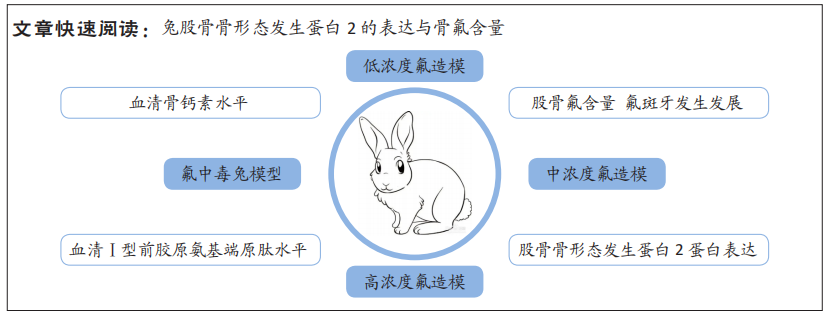中国组织工程研究 ›› 2023, Vol. 27 ›› Issue (17): 2675-2680.doi: 10.12307/2023.158
• 骨组织构建 bone tissue construction • 上一篇
氟中毒兔股骨骨形态发生蛋白2表达与骨氟含量的关系
梁伟叶1,段庆红2,3
- 1贵州医科大学,贵州省贵阳市 550004;2贵州医科大学附属肿瘤医院影像科,贵州省贵阳市 550000;3贵州医科大学附属医院影像科,贵州省贵阳市 550004
Correlation between femur bone morphogenetic protein 2 expression and bone fluoride content in fluorosis rabbits
Liang Weiye1, Duan Qinghong2, 3
- 1Guizhou Medical University, Guiyang 550004, Guizhou Province, China; 2Department of Imaging, Affiliated Cancer Hospital of Guizhou Medical University, Guiyang 550000, Guizhou Province, China; 3Department of Imaging, Affiliated Hospital of Guizhou Medical University, Guiyang 550004, Guizhou Province, China
摘要:

文题释义:
骨形态发生蛋白:又称骨形成蛋白,是一组具有类似结构的高度保守的功能蛋白,属于转化生长因子β家族。骨形态发生蛋白单体由信号肽、前功能区和成熟肽3个部分组成,其结构类似一个扁平的弧形表面,通常包括一个长形的α螺旋和从α螺旋两端发出的两对反向平行β链。成熟的骨形态发生蛋白是由二硫键连接的同型或异型二聚体,均有分子活性,被释放到细胞外后,与靶细胞表面的相应受体结合而发挥作用。Ⅰ型前胶原氨基端原肽:是人体最丰富的胶原蛋白形式,约占骨质的90%。Ⅰ型胶原主要在骨组织中合成,首先合成的是原胶原,在Ⅰ型原胶原的氨基N端和C端各有一个延长肽,分别被称为Ⅰ型原胶原N端前肽和Ⅰ型原胶原C端前肽;当Ⅰ型原胶原被成骨细胞分泌到细胞外时,N端和C端的延长肽会被蛋白酶切割,除少量沉积在骨基质中以外,大量会进入血液循环,最终被肝脏代谢清除。
背景:氟中毒是一种常见的地方性疾病,其严重程度主要取决于氟化物暴露剂量和暴露持续时间。骨形态发生蛋白2在氟骨症发病过程中有重要作用。
目的:探究兔股骨骨形态发生蛋白2表达与骨氟含量的关系,以及骨形成标志物骨钙素与Ⅰ型前胶原氨基端原肽在不同氟浓度下的变化。
方法:将16只新西兰白兔随机分为对照组、低氟组、中氟组和高氟组,每组4只,分别饮用含0,100,200,400 mg/L氟化钠的自来水,饲养期间动物自由饮水、进食,实验周期6个月。观察氟斑牙发生发展情况,采用灰化蒸馏-氟试剂比色法测定兔股骨中氟含量,蛋白免疫印迹法检测股骨中骨形态发生蛋白2蛋白表达,采用酶联免疫吸附实验检测血清骨钙素和Ⅰ型前胶原氨基端原肽水平。
结果与结论:①低氟组以轻度氟斑牙为主,表现为牙齿失去光泽,部分可见细纹;中氟组以中度氟斑牙为主,表现为牙齿表面凹凸不平、色泽不均,个别表现为重度氟斑牙,表现为牙齿缺损;高氟组以重度氟斑牙为主,表现为牙齿表面无光泽,牙齿发育畸形;②随着摄氟质量浓度的升高,兔股骨内骨氟含量增加,其中高氟组骨氟含量高于其他3组(P < 0.01,P < 0.001);高氟组血清骨钙素水平高于对照组
(P < 0.05),血清Ⅰ型前胶原氨基端原肽水平低于对照组、低氟组(P < 0.05);③低氟组股骨内骨形态发生蛋白2表达高于对照组、高氟组(P < 0.05);④Pearson相关分析显示,低氟组骨形态发生蛋白2表达与骨氟含量呈正相关(r=0.951,P < 0.05),中、高氟组骨形态发生蛋白2表达与骨氟含量无显著相关(r=0.889、r=-0.116,P > 0.05);⑤兔股骨骨形态发生蛋白2表达与骨氟含量的相关性与氟暴露浓度有关,过高或过低的氟浓度均会影响骨形态发生蛋白2的表达。
https://orcid.org/0000-0002-7961-3525(梁伟叶)
中国组织工程研究杂志出版内容重点:组织构建;骨细胞;软骨细胞;细胞培养;成纤维细胞;血管内皮细胞;骨质疏松;组织工程
中图分类号: